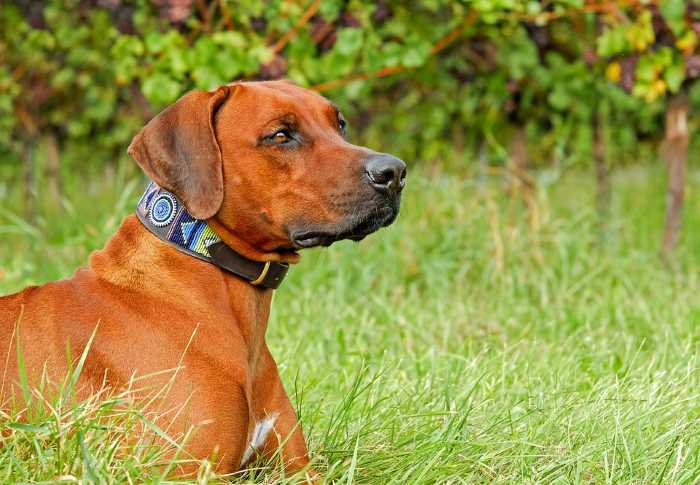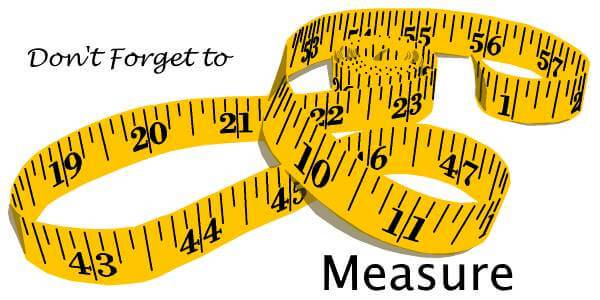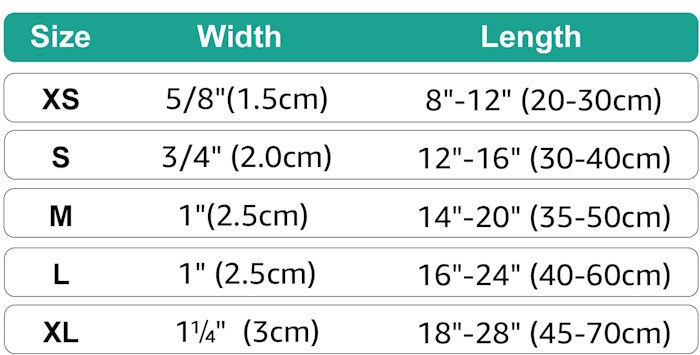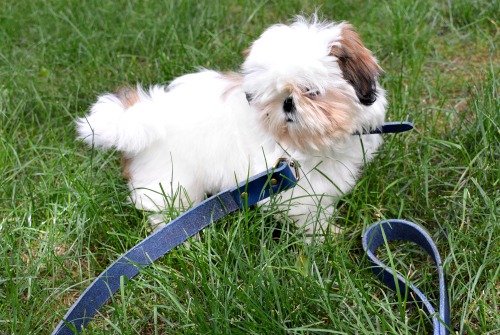- Small Dog Place Home
- Supplies
- Snug Dog Collars
Why Should Dogs Wear Snug Dog Collars?
Snug Dog Collars by Dr. John Brooks |Updated 04-1-2024
Dog collars come in various sizes, types, and materials for all dogs. No matter if they are short, huge, fluffy or scary, they always have to wear the collars when they are owned by a human. There are two purposes of the dog collar.
First, you need a place to attach dog tags (license, rabies vaccination tags) This is especially important when you are taking them for a walk to their favorite spot.
Second, you prefer to attach your dog's leash to the collar. Of course, you may also decide that your small dog should wear a harness instead. This is especially important if you have a brachycephalic breed.
 Snug Dog Collars can be just as beautiful as they are practical.
Snug Dog Collars can be just as beautiful as they are practical.If you are out and about, keeping your dog on a leash is a must. In some locales, it's the law. Even the dogs with the best recall may get distracted by something (a squirrel) so it's best not to take chances.
Why a Snug Dog Collar
Dogs wear whatever their owners put on them, so it is up to you, the dog owner to decide whether a snug collar is a good bet. Actually, it comes down to the Goldilocks principle: Not to Tight, Not to Loose, But Just Right.
A Collar that is Too Loose
If the collar is loose, of course, your dog can wiggle out of it and take off, leaving you holding the end of an empty leash. This is a very bad situation, especially if your dog decides to run.
A loose collar can also get stuck on a branch or something else, possibly strangling him or suffocating him while he waits for help.
A collar that is Too Tight
Tight collars are also bad, but for different reasons. If a collar is too tight, it restricts the airflow to the lungs or cause major trauma to the trachea. You should be able to place a couple fingers under the collar to test for tightness.
Slip two fingers under the collar. If you can do this easily, the collar is just right. If you can slip more than two fingers, then the collar is too loose. If you can't fit two fingers under the collar, then you will need to loosen it to make it more comfortable for your dog.
Sizing for Dog Collars
 The best way to assure your dog is wearing a tight collar is to measure his neck.
The best way to assure your dog is wearing a tight collar is to measure his neck.Most standard dog collars come in sizes from XXS to xxl. You should be able to read the label to determine the length and width of the collar. If the collar is adjustable, which it should be, the length shows the range. You will want to choose the collar size that corresponds to your dog's neck.
How do you do this?
Use a tape measure like the one shown above to measure your dog's neck at the location where you want the collar to be worn. Compare your measurements to those on the collars label.
What about if your dog is between sizes?
The easiest remedy for this is to continue shopping. These are not standard sizes so you may find that one manufacturer has a collar that is perfect for your dog.
If you have your heart set on one particular brand, consider going up one size.

Width of Dog Collars
Once you have a collar that is the proper length, turn your attention to the width. If the collar is way too wide for the dog, he may choke or suffocate at worst and be very uncomfortable at least. It goes without saying that a small dog should wear a thin collar. Some very tiny dogs do well with a cat collar.
You want the collar to fit comfortably so the dog forget's he's even wearing it. A dog who is uncomfortable will let you know by stratching or pawing at his neck.
Match the Width to the Size of the Dog
Collars come in various widths so check sizes. Some companies will allow you to customize the width while others are standard sizes.
A typical collar for a small breed dog would be 5/8" but you may want to consider something smaller for a young puppy learning to wear a collar, such as a 1/4" collar. Collars that come in 3/4" or 1" should be used on larger dogs.
Point to Ponder Before Purchasing Snug Dog Collars
Always remember puppies grows every day. When you have a puppy, you must check that the collar is not too tight. Replace it as your puppy grows. An adult dog will not grow at such a fast pace. However, you still have to check it periodically because your dog cannot talk and he will surely not tell you that he is suffocating.
If you choose to buy from a brick and morter store, take your dog with you and try on the collars that you like. Watch for your dog's reaction. He should act as though nothing has changed. That is a good sign that the collar fits well.
 This collar is too wide and heavy for a small puppy.
This collar is too wide and heavy for a small puppy.Kinds of Snug Dog Collars
As I mentioned above dog collars come in multiple sizes, types, and materials. It means you always have choices. Sometimes too many choices make buying decisions impossible.
Martingale Dog Collars
When taking your dog out for a walk you will put a leash on your dog's collar. If you have a dog that pulls, a martingale collar is an option.
Snug Dog Collars: Leather collars
One of the most common type of dog collars is made of leather. They not only look classy, but they are quite durable and light too. It does not hurt the dog when he wears the leather collar as it feels light. While on the other hand, collars of different materials can hurt your dog. Or in the worst case, they can result in bad allergies.
Snug Dog Collars: Plastic collar
In contrast to leather collars, there are plastic collars in the market too. Synthetic collars are so cheap, and they come in various colors and styles, but they are usually not comfortable.
Besides, you should not take the risk. Imagine your dog going near a heat source, the plastic collar will heat up quickly and even begin to melt, causing severe pain to your dog’s neck. Then you will have to take him to the doctor and see him in pain, while he recovers slowly.
Snug Dog Collars: Nylon Collars
Another very common type of collar for small dogs is made out of nylon. They come in virtually every color and pattern imaginable and some come to match the color of your leash. If you walk your dog at night, consider a reflective one.
If you want to get fancy, there's plenty from which to choose
Snug Dog Collars: Fancy Collars
You get to wear a new and matching dress for every event why not your dog? Your dog must have an elegant and classy dog collar for every occasion, right?
For example, you can get a Christmas collar, or a Halloween one. The best thing is that you can get customized collars too from the dog market. How about getting your dog a wedding theme related collar. Yes, he will be winning hearts at the party. The cute little being will be the handsome buddy in the whole function.
For everyday use, consider a bow-tie collar, which is one that comes with a detachable bow-tie or bandanna. For the girls, choose a collar complete with a flower, star, or even jewelry.
Dog harness Vs. Snug Dog Collars
You do not always have to buy a collar for your dog. There are pretty good alternatives too. One of them is a dog harness. Although harness can be a bit uncomfortable for your dog at first, it all depends upon it's construction and how well it fits.
The advantage of using a harness instead of a dog collar is that your dog will not choke while walking. Besides, the dog identification will also stay attached to the harness, so somebody will definitely return him if he gets lost.
Final words About Snug Dog Collars
It does not matter how old dog is, you will always need a collar for him. If you feel that your dog is uncomfortable or is in pain, then do loosen his collar. He can be suffocating because of the tight collar. While on the other hand, if you see your dog moving without a collar, chances are that the collar is too loose and that you need to tighten it around his neck.
There are multiple options for you to choose from when it comes to choosing a perfect collar or harness for your dog. For some specific occasions, you can also get customized and fancy collars. However, you need to check regularly that the collar is not too tight and not too loose for your dog to avoid unwanted situations.
Author Bio (Snug Dog Collars)
John Brooks is a veterinary surgeon who manages a lot of calls for pet services while also maintaining a quality lifestyle. He has graduated in surgery and veterinary medicine in 1997 and has helped in several small animal practices until 2005 before shifting to critical care and emergency.
Dr. Brooks loves animals from the core of his heart. Whenever he gets time, he tries to write regarding animal health so that all pet lovers like you don’t fall in any hazardous situation.
About Janice (author and voice behind this site)
Having lived with dogs and cats most of her life, Janice served as a veterinary technician for ten years in Maryland and twelve years as a Shih Tzu dog breeder in Ohio.
Her education includes undergraduate degrees in Psychology with a minor in biology, Early Childhood Education, and Nursing, and a master's in Mental Health Counseling.
She is a lifelong learner, a dog lover, and passionate about the welfare of animals. Her favorite breed for over 50 years has been the Shih Tzu, but she has also lived with Poodles, Maltese, Yorkshire Terriers, Beagles, English Bulldogs, Carin Terriers, and a Cocker Spaniel.
When not writing, reading, and researching dog-related topics, she likes to spend time with her eight Shih Tzu dogs, husband, and family, as well as knitting and crocheting. She is also the voice behind Miracle Shih Tzu and Smart-Knit-Crocheting
Does This Article Deserve Your Thumbs Up?
We always appreciate your support and encouragement. Your thumbs up means so much to us. Please like this article.
If you find this page or any page on Small Dog Place Helpful, or useful in anyway, I'd love it if you would click the small heart found on the bottom right of each page.
You can also share or bookmark this page -- just click on the:

Free Monthly Newsletter
Sign Up for Our Free Newsletter and get our Free Gift to You.
my E-book, The Top 10 Mistakes People Make When Choosing a Dog (and how to avoid them)

